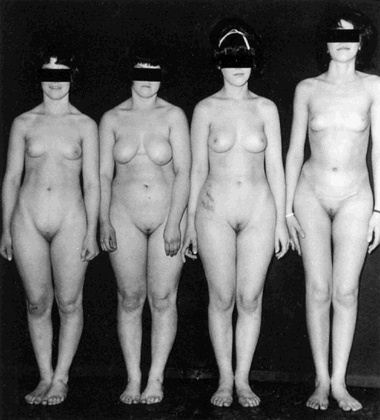
Androgen Insensitivity Syndrome (AIS):
[formerly, Testicular Feminization Syndrome (TFS)] an X-linked recessive trait
AIS is
associated with an Androgen
Receptor locus on the long arm of the X chromosome (Xq11-q12). The
individuals have the XY karyotype typical of males, but develop physically and
psycho-sexually as typical females. Development of some secondary sex
characteristics (e.g., enlargement of the breasts) may be
unimpaired, but axillary and pubic hair are typically absent. A stereotype (with some support
from clinical studies) is that AIS women are often
tall, thin, and unusually attractive, which has led to
unfounded rumors that various actresses or models have AIS.
Often, individuals with AIS
are diagnosed
only when they fail to menstruate at puberty. AIS
appears to be due to an inability of tissues to respond
to androgen. Women with TFS
are invariably sterile, with a blind vagina,
underdeveloped uterus, and (typically) rudimentary testes.
Consequently, the AIS allele
is not passed on by XY individuals, but by their asymptomatic heterozygous XX sisters.
Institution of gender testing in international athletic competition, notably the 1968 Olympic Games, was intended to identify male athletes who allegedly sought a competitive advantage by "passing" as female, after having undergone hormone treatment. No such individuals were detected, however women with AIS and an XY karyotype who therefore "tested negative" for Barr Bodies were routinely identified, and in some cases deprived of their medals. This goes to general questions of LGBT persons in sport. The former designation of this syndrome as TFS has been replaced by AIS, because of the implication that the women are "feminized men" rather than women with an atypical karyotype.

Institution of gender testing in international athletic competition, notably the 1968 Olympic Games, was intended to identify male athletes who allegedly sought a competitive advantage by "passing" as female, after having undergone hormone treatment. No such individuals were detected, however women with AIS and an XY karyotype who therefore "tested negative" for Barr Bodies were routinely identified, and in some cases deprived of their medals. This goes to general questions of LGBT persons in sport. The former designation of this syndrome as TFS has been replaced by AIS, because of the implication that the women are "feminized men" rather than women with an atypical karyotype.